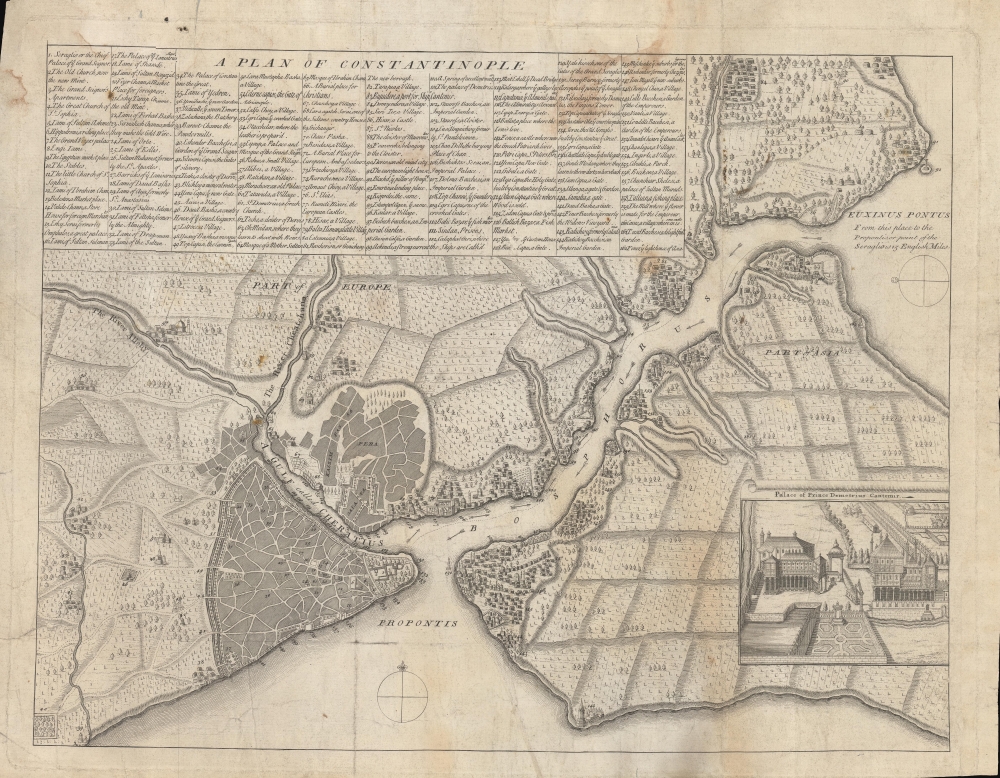Digital Image: 1735 Cantemir Map of Istanbul / Constantinople
Constantinople-cantemir-1734_d
Title
1734 (undated) 14 x 18.25 in (35.56 x 46.355 cm)
Description
FOR THE ORIGINAL ANTIQUE MAP, WITH HISTORICAL ANALYSIS, CLICK HERE.
Digital Map Information
Geographicus maintains an archive of high-resolution rare map scans. We scan our maps at 300 DPI or higher, with newer images being 600 DPI, (either TIFF or JPEG, depending on when the scan was done) which is most cases in suitable for enlargement and printing.
Delivery
Once you purchase our digital scan service, you will receive a download link via email - usually within seconds. Digital orders are delivered as ZIP files, an industry standard file compression protocol that any computer should be able to unpack. Some of our files are very large, and can take some time to download. Most files are saved into your computer's 'Downloads' folder. All delivery is electronic. No physical product is shipped.
Credit and Scope of Use
You can use your digial image any way you want! Our digital images are unrestricted by copyright and can be used, modified, and published freely. The textual description that accompanies the original antique map is not included in the sale of digital images and remains protected by copyright. That said, we put significant care and effort into scanning and editing these maps, and we’d appreciate a credit when possible. Should you wish to credit us, please use the following credit line:
Courtesy of Geographicus Rare Antique Maps (http://www.geographicus.com).
How Large Can I Print?
In general, at 300 DPI, you should at least be able to double the size of the actual image, more so with our 600 DPI images. So, if the original was 10 x 12 inches, you can print at 20 x 24 inches, without quality loss. If your display requirements can accommodate some loss in image quality, you can make it even larger. That being said, no quality of scan will allow you to blow up at 10 x 12 inch map to wall size without significant quality loss. For more information, it is best consult a printer or reprographics specialist.
Refunds
If the high resolution image you ordered is unavailable, we will fully refund your purchase. Otherwise, digital images scans are a service, not a tangible product, and cannot be returned or refunded once the download link is used.
Cartographer S
Demitrie Cantemir (October 25, 1673 - August 21, 1723) was a Moldavian prince, historian, and polymath active in Moldavia and Istanbul. Cantemar served as voivode of Moldavia (March-April 1693 and 1710 - 1711). During most of the interim period (1687 - 1711), he lived as hostage or 'envoy' in Constantinople, though graciously in a private palace (illustrated here). There he learned Turkish and studied Ottoman history at the Patriarchate's Greek Academy. During this period, he composed his best-known work, the History of the Growth and Decay of the Ottoman Empire (originally in Latin, Historia Incrementorum Atque Decrementorum Aulae Othomanicae). This volume circulated throughout Europe in manuscript for years, before N. Tindal translated and published it in London in 1734. It remained the seminal work on the Ottoman Empire up to the middle of the 19th century; notably, it was used as a model for Edward Gibbon's Decline and Fall of the Roman Empire. Current scholarship has criticized Cantemir's sources as dubious. With Ottoman approval, he returned to power in Moldavia in 1710. His reign was marked by attempts to stabilize and modernize his principality. In 1711 he aligned Moldavia with Russia in the Russo-Turkish War (1710 - 1711), hoping to secure independence from the Ottomans. However, the alliance was unsuccessful, and after the Battle of Stănilești, Cantemir was forced into exile in Russia under the protection of Tsar Peter the Great. He died in 1723 in Dmitrovsk, Russia. More by this mapmaker...
Nicolas Tindal (November 25, 1688 - June 24, 1774) was a British scholar and translator active in the early - mid 18th century. Tindal was born in Plymouth, England, the son of a Rector and Vicar. He studied as Exeter College, Oxford, from which he received a degree in 1713. His most significant work is his English translation and continuation of Paul de Rapin's multi-volume History of England, bringing it currently to the reign of George II (1727 - 1760). Nonetheless, he also translated other historical texts and his contributions have since been recognized as foundational in the study of British history. Learn More...

